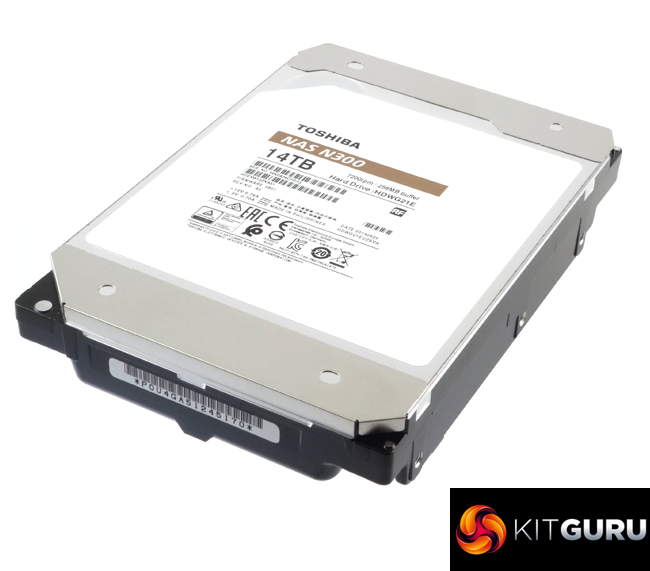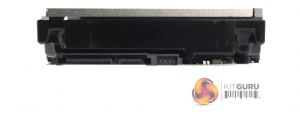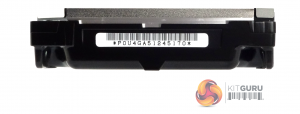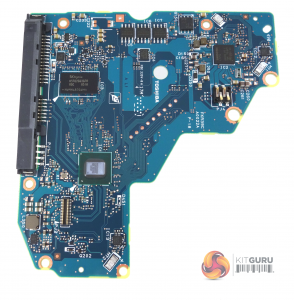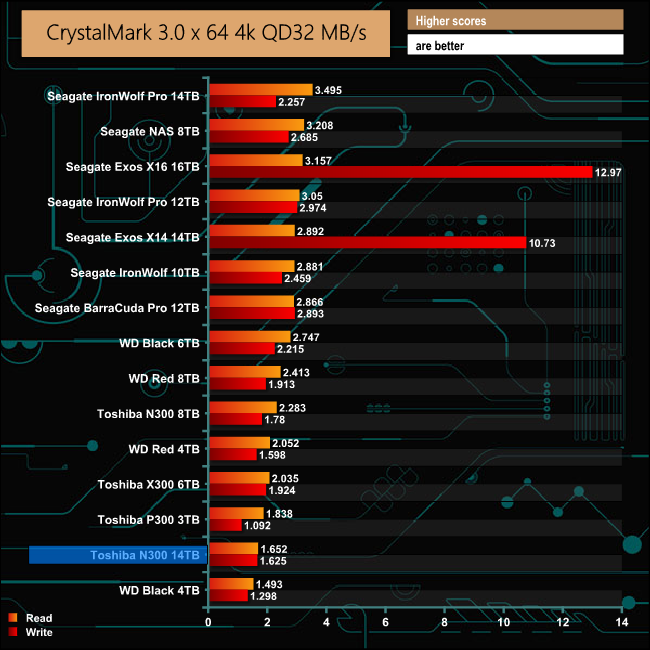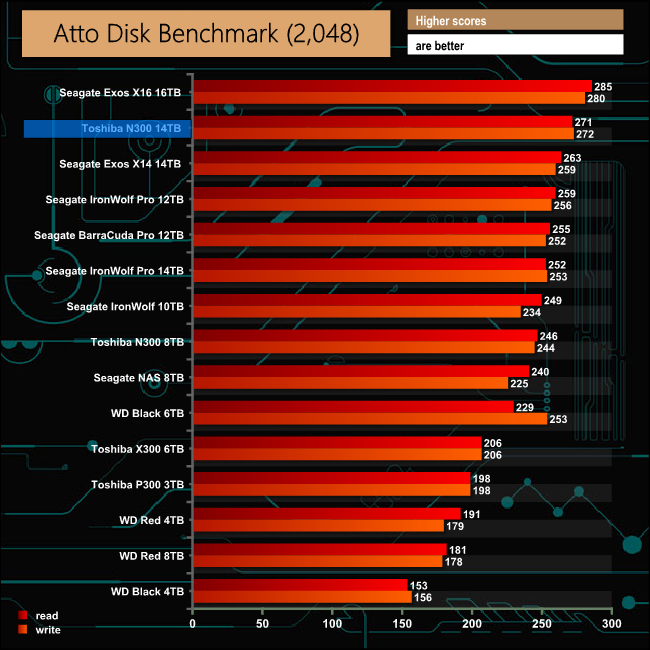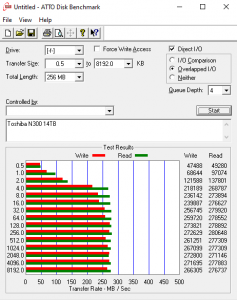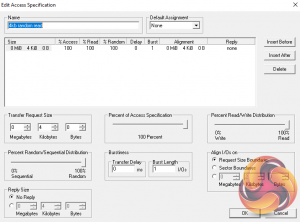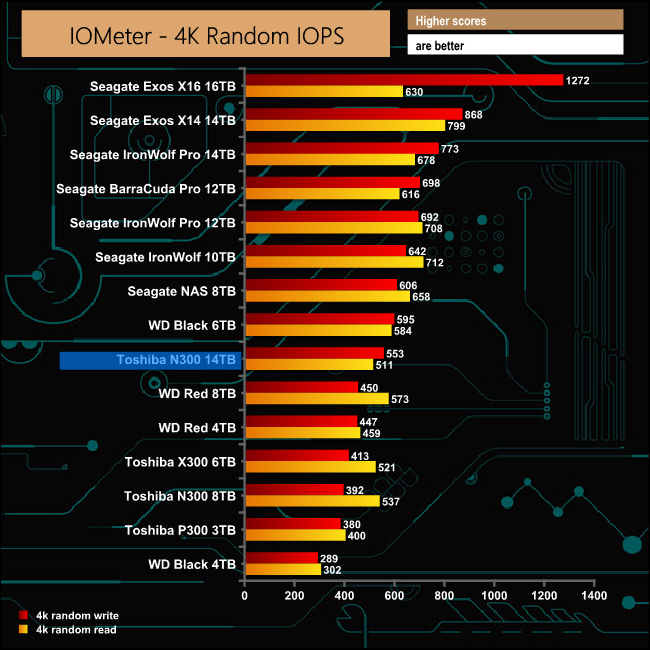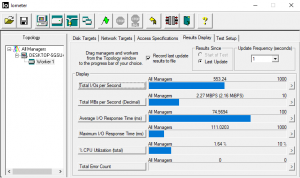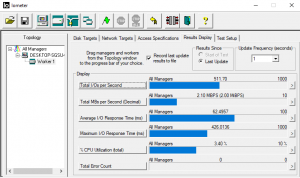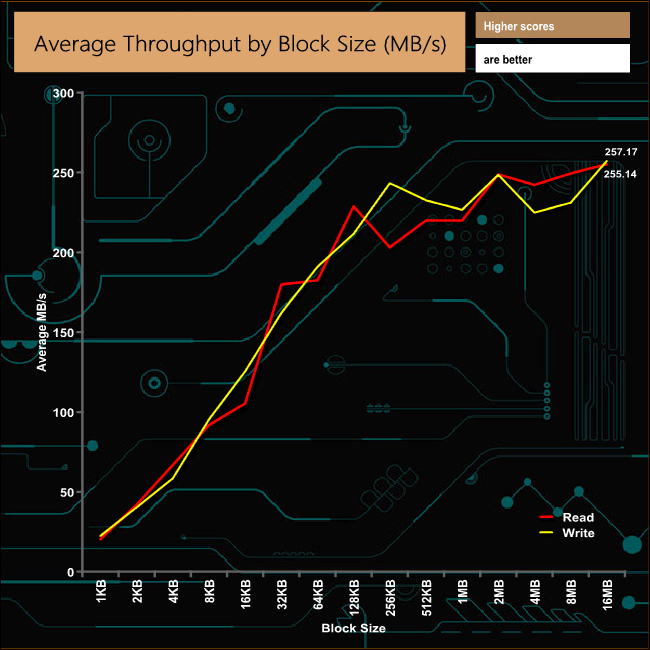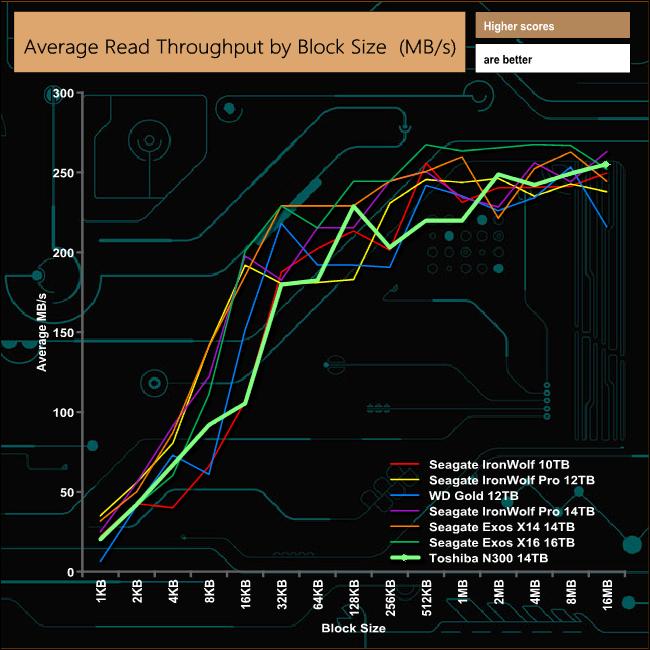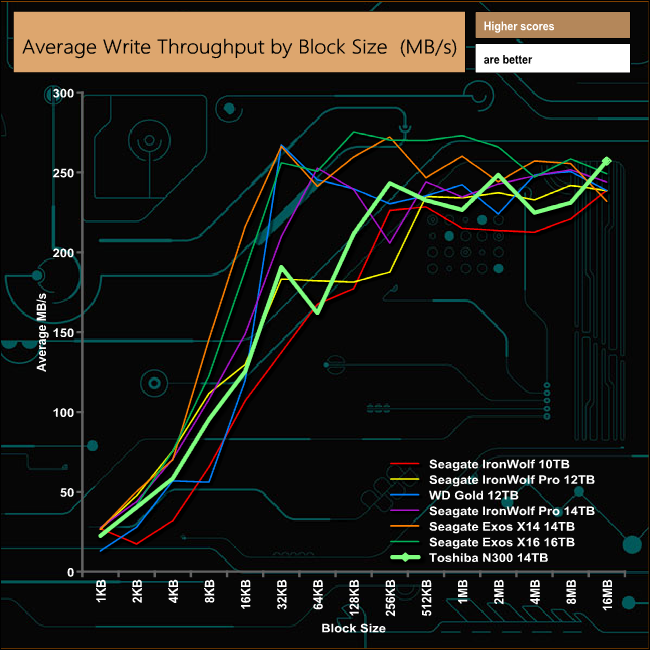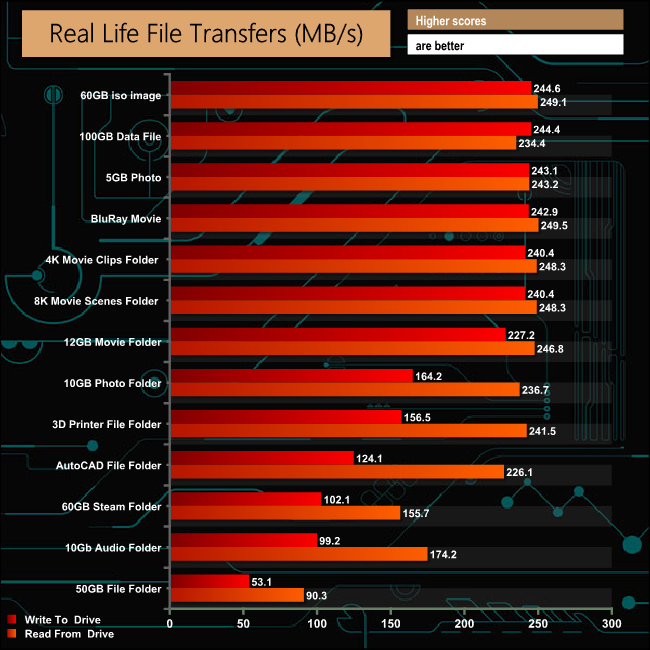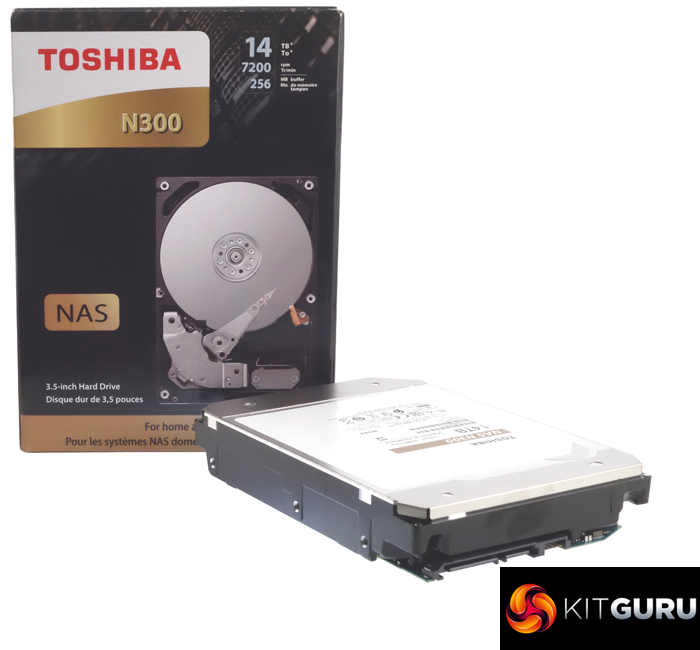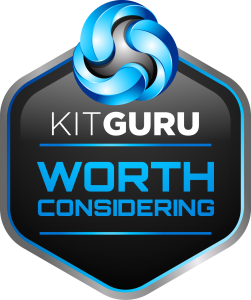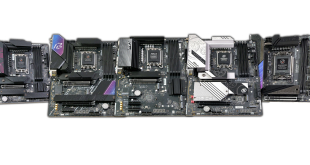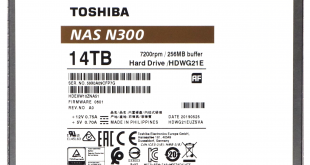
Toshiba's N300 NAS family of hard drives have been designed for use in high-performance personal, home office and small business NAS systems. The 14TB hard drive is one of three N300 drives in the line-up that (at the time of writing) make use of Helium technology.
The N300 NAS series comes, as you might expect for a drive aimed at NAS enclosures in a wide range of capacities; 4TB, 6TB, 8TB, 10TB, 12TB, 14TB and the very recently released new flagship 16TB model. The 12TB, 14TB and 16TB models are the only ones that make use of Helium technology.
All the drives in the range have a spin speed of 7,200rpm while cache size differs with capacity. The 4TB, 6TB and 8TB models get 128MB, the 10TB, 12TB and 14TB models get 256MB while the 16TB drive uses a 512MB cache.
Toshiba rate the data transfer speed of the 14TB N300 NAS as 260MB/s with an average latency of 4.17ms. Power consumption for the drive is quoted as a typical 6.77W for active read/write and 4.54W for active idle.
The 14TB drive has a workload rating of 180TB/year and Toshiba back the drive with a 3-year limited warranty.
Physical Specifications:
- Usable Capacities: 14TB
- Spindle Speed: 7,200rpm.
- No. Of Heads: 18.
- No. Of Platters: 9.
- Cache: 256MB.
- Recording Method: Perpendicular.
- Helium technology: Yes.
- Interface: Serial ATA (SATA) 6Gb/s (SATA III).
- Form Factor: 3.5in.
- Dimensions: 147 x 101.85 x 26.1mm.
- Drive Weight: 720g.
Firmware Version: 0601.
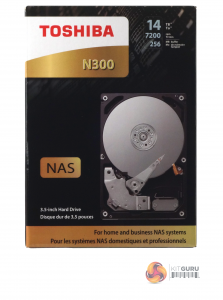
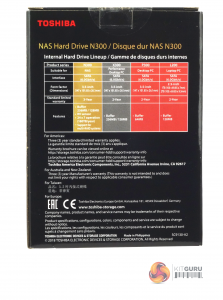
The sturdy box for the Toshiba N300 has an image of an open drive on the front, together with clear descriptions of its capacity, spin speed, cache and usage.
The back of the box has a useful panel displaying Toshiba's internal hard drive line-up, which includes what the drive is suitable for, form factor, warranty and features list. Under this are worldwide warranty details.
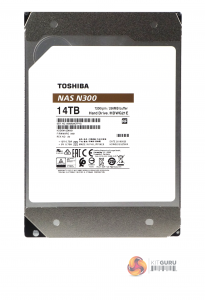
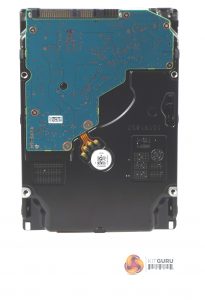
Built on a standard 3.5in format but with an increased 26.1mm height, the 14TB N300 NAS uses nine 1.55TB platters (discs) with eighteen read/write heads. The drive features several technologies designed to increase reliability in a multi-disk environment.
The 14TB N300 series features a 256MB cache and uses Toshiba’s Dynamic Cache Technology to optimise cache allocation during read/writes to maintain high performance. The drives also have Toshiba Stable Platter technology which helps minimise the effects of system vibration by the use of a tied spindle motor which secures the motor drive shaft at both ends.
Also helping the fight against vibration are built in sensors which detect shock and rotational vibration and compensate for both. RV (rotational vibration) may not seem much of a problem when you only have a couple of drives in the same enclosure but when there are six or more drives in the same box it can become a real issue.
A quick look at the underside of the PCB reveals an Avago DT0252 controller, a SK hynix H5TQ2G63GFR DDR3-1866 DRAM IC and a Smooth L7291 spindle controller. There are also three vibration sensors, the angled silver coloured units on the PCB.
For testing, the drives are all wiped and reset to factory settings by HDDerase V4. We try to use free or easily available programs and some real world testing so you can compare our findings against your own system.
This is a good way to measure potential upgrade benefits.
Main system: Intel Core i7-7700K with 16GB of DDR4-3200 RAM, Sapphire R9 390 Nitro and an Asus Prime Z270-A motherboard.
Other drives:
Seagate NAS 8TB
Seagate Exos X16 16TB
Seagate Exos X14 14TB
Seagate IronWolf Pro 14TB
Seagate BarraCuda Pro 12TB
Seagate IronWolf Pro 12TB
Seagate IronWolf 10TB
Toshiba N300 8TB
Toshiba P300 3TB
Toshiba X300 6TB
WD Gold 12TB
WD Black 6TB
WD Black 4TB
WD Red 4TB
WD Red 8TB
Software:
Atto Disk Benchmark.
CrystalMark 3.0.3.
IOMeter
All our results were achieved by running each test five times with every configuration this ensures that any glitches are removed from the results.
Crystalmark is a useful benchmark to measure theoretical performance levels of hard drives and SSD’s. We are using V3.0.3. to test HDDs.
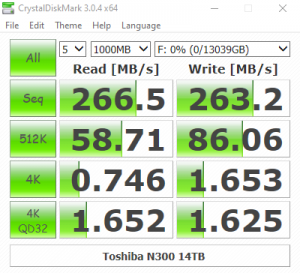
Our review sample 14TB N300 didn't handle the CrystalDiskMark 4K tests particularly well, in fact it was a little slower than the 8TB version we've reviewed previously.
The ATTO Disk Benchmark performance measurement tool is compatible with Microsoft Windows. Measure your storage systems performance with various transfer sizes and test lengths for reads and writes. Several options are available to customize your performance measurement including queue depth, overlapped I/O and even a comparison mode with the option to run continuously.
Use ATTO Disk Benchmark to test any manufacturers RAID controllers, storage controllers, host adapters, hard drives and SSD drives and notice that ATTO products will consistently provide the highest level of performance to your storage.
Toshiba quote transfer rates for the drive at 260MB/s. With the ATTO benchmark, we managed to squeeze a little more out of the drive with 271MB/s for reads and 272MB/s for writes, making it the second fastest HDD drive we've tested to date behind Seagate's 16TB Exos X16.
IOMeter is another open source synthetic benchmarking tool which is able to simulate the various loads placed on a hard drive and solid state drive technology.
We test with both random read and write 4k tests, as shown above. There are many ways to measure the IOPS performance of a hard drive, so our results will sometimes differ from manufacturer’s quoted ratings. We do test all drives in exactly the same way, so the results are directly comparable.
In our 4K random read/write tests the 14TB N300 was slower than the other two 14TB drives on the chart, Seagate's IronWolf Pro and the Exos X14.
Toshiba's official transfer rate figure for the 14TB N300 is 260MB/s. In our throughput tests the drive didn't hit this maximum figure, but it was certainly in the ballpark with reads of 257.17MB/s and writes at 255.14MB/s.
To test real life performance of a drive we use a mix of folder/file types and by using the FastCopy utility (which gives a time as well as MB/s result) we record the performance of drive reading from & writing to a 256GB Samsung SSD850 PRO.
We use the following folder/file types:
- 100GB data file.
- 60GB iso image.
- 60GB Steam folder – 29,521 files.
- 50GB File folder – 28,523 files.
- 12GB Movie folder – 24 files (mix of Blu-ray and 4K files).
- 10GB Photo folder – 621 files (mix of .png, raw and .jpeg images).
- 10GB Audio folder – 1,483 files (mix of mp3 and .flac files).
- 5GB (1.5bn pixel) photo.
- BluRay Movie.
- 21GB 8K Movie demos.
- 11GB 4K Raw Movie Clips (8 MP4V files).
- 4.25GB 3D Printer File Folder (mostly .STL).
- 1GB AutoCAD File Folder (.dwg and .dxf).
The N300 dealt with the real life file transfers pretty well. The 60GB Steam folder and in particular the 50GB file folder transfers are ones that quite often cause problems in terms of slowing a drive down, as it proved with the N300, but apart from those and the 10GB Audio folder, it dealt with transferring the files very efficiently.
Thanks to Helium technology, Toshiba have been able to get nine platters (discs) in a 3.5in format, albeit with a deeper, 26.1mm enclosure. The drive has a spin speed of 7,200rpm and comes with 256MB of cache. The drive uses Toshiba’s Dynamic Cache Technology to optimise cache allocation during read/writes to maintain high performance.
Helium technology not only allows you to cram more discs in a 3.5in format, it also a handy tool to have in the fight to keep power consumption as low as possible. This benefit is nicely highlighted by the official power ratings. The power figures for the 14TB N300 are 6.77W typical when in operation and 4.54W when in active idle mode. Both of those figures are lower than the non-helium 8TB N300 model we previously reviewed, which was rated at 9.2W operating and 6.2W in active idle.
Having lots of hard drives inside a single enclosure, (the N300 series supports up to 8 disk enclosures) can lead to problems due to vibration and Toshiba have equipped the N300 with technologies to try and counteract any potential problems. Toshiba’s Stable Platter technology utilises a tied spindle motor to stabilise the motor drive shaft at both ends to protect against system-induced vibration, while Toshiba’s Ramp Load technology reduces disk head wear and tear.
The drive also has three built-in rotational vibration sensors to detect and compensate for drive vibration problems that might occur in multi-disk enclosures which can be a real cause for concern.
Toshiba quote a sustained transfer rate for the 14TB N300 at 260MB/s, something we were able to confirm with the ATTO benchmark, the reviewed disk producing figures of 271MB/s for reads and 272MB/s for writes.
We found the 14TB Toshiba N300 on Amazon UK for £369.96 HERE
Pros
- Fast Sequential performance.
- Extra features aid reliability in a NAS environment.
Cons
- 4K performance not as good as some of the competition.
KitGuru says: It's taken a while for Toshiba to add very large capacities to the N300 series, but with the 14TB model and the more recently released 16TB model they are now keeping pace with the competition.
 KitGuru KitGuru.net – Tech News | Hardware News | Hardware Reviews | IOS | Mobile | Gaming | Graphics Cards
KitGuru KitGuru.net – Tech News | Hardware News | Hardware Reviews | IOS | Mobile | Gaming | Graphics Cards


